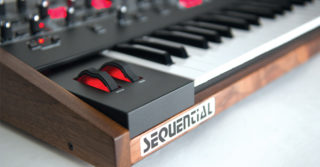 Sequential has released a free OS update for the Prophet-6 and the OB-6 that adds MPE support, ‘vintage mode’ and more.
Sequential has released a free OS update for the Prophet-6 and the OB-6 that adds MPE support, ‘vintage mode’ and more.
The company says that the updates ‘significantly enhance the expressivity of both instruments’.
Here’s what’s new:
- Support for MPE (MIDI Polyphonic Expression). This lets the Prophet-6 and OB-6 respond to MPE-driven controllers, including the LinnStrument, Expressive E Osmose, Roli Seaboard series and others.
- Prophet-5 Rev 4-style “vintage” mode. This gives the Prophet-6 and OB-6 a ‘looser, more organic sound’ that emulates the behavior of vintage synthesizers, where the behavior of individual oscillators, filters, and envelopes vary from voice to voice.
- Improved aftertouch curves for enhanced expressiveness, when using the Prophet-6 and OB-6’s own keyboard.
See the Sequential site for details.

the mpe and the vintage mode is awsome update!!
So.. if the best filter model is the SSM that prophet 6 is based on and it’s got the updates to make it the same as the prophet 5. Really giving up one octave you get fantastic FX, a sequencer and a much more transportable package.
Kinda finding it hard to work out how the 5 looks the better buy here
prophet 5 costumers don’t care about logic
more wood?
I have both, and I love my P6, but it is NOT a Prophet 5 (rev4). The VCOs on the P5 are more organic, and “vibey” – i know these are intangible buzzword descriptions, but it has an incredibly pleasing feel to it on even the simplest patches. The moog One is similar in my opinion. When they are effected, and slammed in a track, then the differences are far less noticeable but playing the 2 (p5 vs p6) is a different experience.
I prefer the sound of the prophet 6 to the prophet 5. it’s much upgraded synth in any regard and looks nicer to me. still they both much too simple to my taste.
I will prefer 16 voice rev2. hope they will give it a vintage mode too.
So…what would be the best way to connect a Roli Rise to the OB6?
Quantum tunneling MIDI and/or wireless neurolink directly from your brain.
Otherwise, any of the following might potentially work: 1) computer acting as MIDI bridge; 2) hardware MIDI bridge (I have an iConnectMIDI and a PUC); 3) BlueTooth to 5-pin MIDI adapter.
If you can get it to work, I think the BlueTooth to 5-pin adapter might be the most convenient. Basically plug the adapter into the OB6 and then pair it with the Roli via BlueTooth.
The most foolproof way is probably to just connect both devices to a laptop then turn on MIDI bridging (on a Mac this is done with the Audio MIDI Setup app.)
iconnectivity call it “midi bridge” but usually it’s called “midi host”
It’s MIDI bridging because it’s bidirectional (indeed as MIDI usually is.) MIDI is symmetric.
USB however, is generally not symmetric (unfortunately.) Most USB MIDI devices only support USB client/device mode, and you need a USB host to connect to them. That’s why you can’t usually easily connect a USB MIDI controller directly to a USB MIDI synth module, unless one of them supports USB host mode. It is a real deficiency of USB MIDI compared to 5-pin MIDI !!
The key bit is that even after you connect your USB host (I’ve typically used the iConnectMIDI or the PUC or a Raspberry Pi connected to a 5-pin MIDI interface on one side and USB MIDI on the other) you typically need to activate MIDI bridging between the controller and keyboard. As I’ve noted on a Mac you can to this with Audio MIDI Setup. On the Pi I wrote a simple program to do it – all it does is poll both MIDI devices and route messages between them.
Interestingly enough the Raspberry Pi zero supports USB gadget mode so it can potentially act as a client device as well as a host device.
@gadi thanks for the reply – do you know of any other good/inexpensive devices to work as a hardware midi bridge/midi host?
it is really just the way iconnectivity chooses to call it. I guess they took it from a utility software’s that links two midi software.
if you looking to connect a hardware usb controller to 5 pin din midi synth you better search for “midi host”, midi bridging will not give you what you looking for.
no need to set anything. usb host don’t usually connect to the computer unless they have other features.
you just connect your roli to midi host box that send midi out to the synth.
if the roli is class complaint (works without a driver) it will work.
i use kenton usb host, it’s not the cheapest.
you can find many today. most works fine.
Very nice! I have some OS updating to do…
oh boy oh boy 🙂
Flawless OB-6 update with MidiOx. This sounds really good.
It isn’t well known, but the Prophet ’08/Rev2 actually support polyphonic aftertouch from an external controller (I’ve connected it to a CME Xkey as well as a KMI QuNexus and K-Board.) And of course the Tetra supports channel aftertouch for each voice, much like MPE.